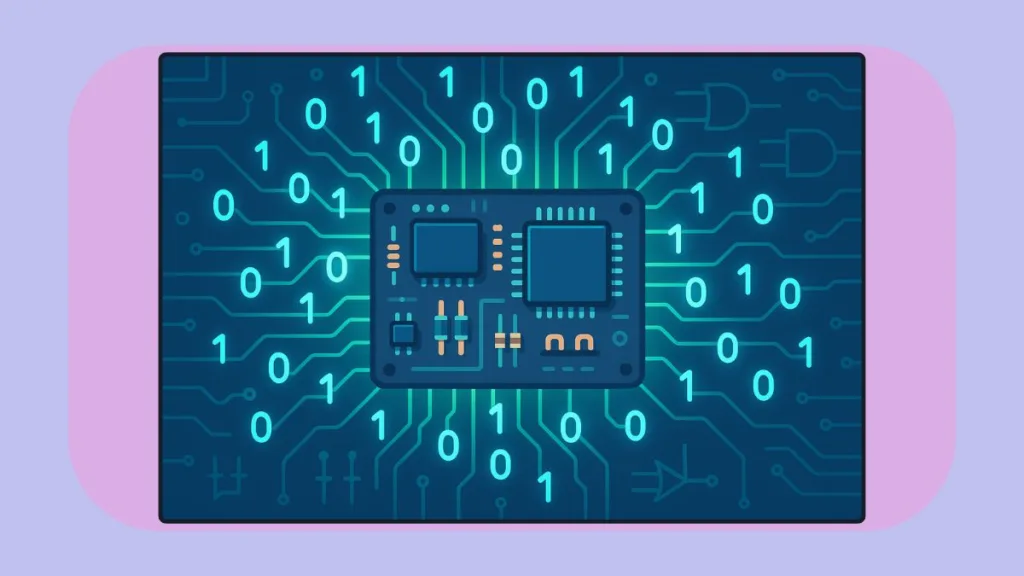Discover why computers use binary and how 0s and 1s, bits, transistors, and logic gates make modern computing fast, reliable, and efficient. Learn in a simple, easy-to-understand way.
Have you ever wondered why computers only seem to understand 0s and 1s? Why not 0 to 9, or even letters like A, B, C?

The answer has less to do with complex math and more to do with a simple, powerful idea: on and off. It’s where brilliant engineering meets the simple logic of a light switch.
What Is Binary?
Binary is a way of representing information using only two states:
- 1 = On
- 0 = Off
Each 0 or 1 is called a bit, the smallest possible piece of data a computer can store. Think of it like a light switch: the light is either on or off. That’s it. No dimmer, no half-on—just simple on/off.
Why Not Use More Numbers?
You might think: “Why not have a system with 3, 10, or even 26 states?” In theory, you could—but in practice, it’s a huge headache.
Here’s why:
- Electric signals aren’t perfect
Every wire and transistor in your computer carries electricity, but electricity can weaken over time. Imagine trying to measure half-on, three-quarters-on, and fully-on perfectly in every wire—it’s almost impossible. - Complexity grows exponentially
More states mean every component must detect tiny differences in voltage. Even a slight change (like your computer heating up) could make the system think “half-on” is actually “fully-on,” causing errors. - Reliability drops fast
With more than two states, circuits would constantly fail, and computers would become super unreliable. You’d be replacing components every few minutes just to keep them working.
Binary Makes Life Easy with Transistors and Logic Gates
This is where binary shines:
- Only two states to detect: on or off.
- Even if the electricity isn’t perfect, a computer can still figure out if it’s a 0 or 1.
This on/off signal is controlled by billions of microscopic switches called transistors. Because they only have to be on or off, they can operate incredibly fast and reliably.
These transistors are then combined into simple structures called logic gates, which use the principles of Boolean logic to make decisions. By combining millions of these gates, a computer can perform complex calculations—all built from simple 0s and 1s!
Analog vs Digital: A Quick Comparison
Before binary became standard, some computers used analog circuits. Analog circuits could handle a range of values, like volume knobs on a speaker. Sounds fancy, right?
Problem: noise. Even a tiny variation in the signal could mess everything up. Binary doesn’t care about small variations—on is on, off is off—so it’s much safer and easier to work with.
A Fun Analogy
Imagine you’re tossing coins to send a secret message. You only have heads or tails to work with. Even if the coin lands slightly crooked, you can still tell heads from tails.
Now imagine using a coin with ten different sides. One small bump, and your friend might misread the message entirely. That’s why binary is our coin with just two sides: simple and reliable.
Conclusion: The Magic of 0s and 1s
So, why do computers use binary?
- Because electricity is messy.
- Because components degrade over time.
- Because simple on/off signals are reliable and efficient.
- Because transistors and logic gates can turn these 0s and 1s into the complex computing we rely on every day.
Thanks to binary, computers can process millions of instructions per second without breaking a sweat. And now you know the reason isn’t just math—it’s engineering and logic working together.
Check out our latest posts on the Blog Page!
I’m Vanshika Vampire, the Admin and Author of Izoate Tech, where I break down complex tech trends into actionable insights. With expertise in Artificial Intelligence, Cloud Computing, Digital Entrepreneurship, and emerging technologies, I help readers stay ahead in the digital revolution. My content is designed to inform, empower, and inspire innovation. Stay connected for expert strategies, industry updates, and cutting-edge tech insights.
